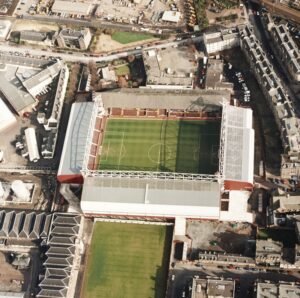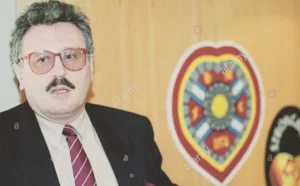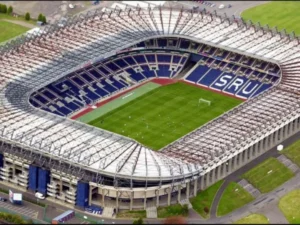
As part of my role as Scottish correspondent for Groundtastic magazine I wrote a number of club articles dedicated to a particular stadium. I hugely enjoyed visiting new towns and cities to unearth some architectural gems of the football world. As a roving reporter I visited Caledonian Stadium, Firs Park, Victoria Park, Borough Briggs, and completed a tour of the football grounds of the Highland League to name but a few.
I have recently been watching the vlogs of Footy Adventures, which I would heartily recommend to those of you who are interested in football stadiums and architecture. These vlogs are exactly the sort of thing that I would have been producing if things were different. Sadly, I have been held back by a progressive, genetic disease of the nervous system, the related disability, a lack of technical expertise to produce videos and being in Scotland at the wrong time, with the wrong person.
I suppose what I have done as an alternative is to write Every Silver Lining has a Cloud, which is an autobiographical tour of the Welsh Premier League football grounds. For those who have yet to read it – shame on you. I am happy with my own contribution to the world of football architecture, but I can’t help having feelings of envy and jealousy as I watch the ever increasing body of vlogs produced by Footy Adventures.
I have decided to reproduce the club articles and photographs that I managed to take during my time in Scotland. This was a difficult time for myself as I was beginning to feel the full effects of living with Friedreich’s Ataxia. It would obviously difficult having to rely on trains to get me to my desired destination and the fact that I was losing my dexterity meant that it was increasingly difficult to take decent photographs.
Unfortunately, I have been unable to find the photographs that I took at Tynecastle or Murrayfield. This is a shame as I remember exactly what happened when I returned home and looked through the substandard photographs I had taken. It was embarrassing having to email the editors of Groundtastic to ask them if they could delve into their substantial photographic library to find pictures to accompany my words. I just couldn’t take a decent photo and did not have the technical skills to perfect lousy camera skills with a little editing. For the purposes of this blog, I have had to sort photos from the internet and by clicking on each image, you will be transferred to the original home of the photograph.
Overall, I am happy with my contribution to Grountastic magazine, and hope the following is of interest to some of you. The articles appear in their original form, but I have updated some of the archaic website addresses that certain clubs had.
***

Home is where the Hearts play, but where that will be next season is anyone’s guess. The Jambos have been based at Tynecastle for 118 years but the future of this famous old ground is hanging in the balance.

Ever since the dawn of the new Millennium, Hearts chief executive Chris Robinson has been trying to move the club from the cramped confines of Tynecastle. This appears strange given the fact that between 1994 and 1997, Tynecastle was revamped with the construction of the all-seater Wheatfield, Roseburn and Gorgie stands in quick succession. The original plan was to rebuild the McLeod Street stand (built between 1914 and 1919 by Archibald Leitch) to mirror the three new stands but, according to Robinson, due to constrictions of space and prohibitive land costs the redevelopment was not deemed viable.

Robinson, who also owns 20% of the shares in Heart of Midlothian, remains adamant the club need to sell their ground to survive in the long term despite the recent improvements. A proposed move to a purpose-built stadium at Braehead Quarry on the outskirts of Edinburgh, fell through and the club turned its attentions to the west of the city before examining a controversial plan to groundshare with Hibernian at Straiton. This plan would have allowed both clubs to sell their grounds, clear their debts and enjoy the benefits of a purpose-built home as the land-owning consortium behind the proposals had planned to donate the land to the project, free of charge. However, after doubts were expressed with the access and egress of the site, Hibs bosses went cold on the idea, deciding to complete reconstruction of Easter Road instead.

With Hearts debts spiralling out of control – the club are reportedly £18m in the red – and sites for a new development in seemingly short supply, Robinson opened negotiations with the Scottish Rugby Union (SRU) about becoming tenants at nearby Murrayfield. The proposal moved a step closer at an SPL Emergency General Meeting in March 2004 when league chiefs permitted groundshare schemes.
Robinson attempted to convince Hearts supporters of the need for such a move in an 18-page feasibility report entitled ‘Tynecastle Stadium: Not Fit for Purpose’. The document tells how Tynecastle no longer complies with new UEFA licensing laws that demand minimum dimensions for the playing field and arena. To conform to these regulations the club would have to reconstruct the entire stadium due to the close proximity of the three new stand’s support towers to the pitch. Another cause for concern is Leitch’s McLeod Street Stand as it’s safety certificate is under threat due to the asbestos roof, timber frame of the main seating deck and corrosion of the internal steal beams. Robinson goes on to inform the reader of prohibitive land costs around the stadium, the difficulty of achieving planning permission and the advantages of moving to Murrayfield.

However, Hearts fans were unmoved and believed the proposals put forward by Robinson could be the beginning of the end for the Jambos. Supporters groups such as Save our Hearts (www.saveourhearts.co.uk) were formed with the express aim of removing Robinson from office, raising funds to purchase shares in the club and achieving supporter representation at Board level. John Borthwick, Secretary of the Federation of Hearts Supporters Clubs, said, “We believe that the proposed move to Murrayfield will signal the death of the Club. The figures released by the present Board predict income of £7.5m at Murrayfield. This is not credible given the present income at Tynecastle of around £6m. Unfortunately, the present Board continue to ignore the supporters and refuse to reconsider the discredited and wholly unnecessary decision to move away”.

Fortunately, Tynecastle won a stay of execution when George Foulkes MP replaced Doug Smith as chairman of Hearts and decided to delay the move until the 2005/06 season – considering other options in the meantime. One such option was The McGrail Plan. Robert McGrail proposes to buy Tynecastle and lease it back to the club. His plans for the development of the stadium can be found at www.heartsforhearts.co.uk but before McGrail had finalised negotiations Hearts announced that they had made a conditional sale to Edinburgh based Cala Management for £22m. The club also confirmed to the Stock Exchange that they had reached an agreement with the SRU to share Murrayfield. However, hope springs eternal for opponents to the move as Hearts have retained the right to withdraw from the sale to Cala should a more attractive option be tabled by January 31.

The latest twist in the tale comes from Lithuania and is known as Vladimir Romanov (above). The wealthy buyer has increased his stake in the club to 29.905% after negotiations to buy-out Chris Robinson and former chairman Leslie Deans. If Romanov should raise his holding further to more than 30%, he will be obliged under Stock Exchange rules to mount a formal takeover bid. This would mean he has to make an offer to buy every single share in the club. Hearts fans will subsequently be hoping that a new owner and board will pull out of the deal with Cala or at least negotiate a deal that will allow the club to remain at Tynecastle while a purpose-built stadium is constructed.
As for the two grounds in question, there may only be two miles separating them but in terms of design they are poles apart. Tynecastle as it stands today is a beautiful mixture of old and new trapped within narrow streets and tenements with steep uncovered stairwells giving access to the middle of equally steep stands. Each stand is remarkably close to the pitch, which helps provides a fantastic atmosphere when major opposition comes to town, and the three new structures are defined by tubular steel goalpost structures, positioned at the front of the stand. The corner support towers are characterised by floodlights that are angled downwards to create maximum impact and further increase the sense of enclosure.

On the face of it Murrayfield has everything Hearts could wish for including car parking, corporate facilities, undersoil heating, press facilities, space for perimeter advertising and seating without limited sightlines. In fact, Murryfield has already hosted Hearts when 18,769 turned up on September 16 to watch the Jam Tarts beat SC Braga 3-1 in the first round of the UEFA Cup. After qualifying for the group stages, Hearts will continue their European adventure at Murrayfield after UEFA decided to implement their licensing proposals discussed earlier. There is no doubting Murrayfield deserves its status as an international class stadium but whether it can successfully house Hearts for a sustained period is another matter.
The average attendance at Tynecastle over the past three season’s has been around the 11,000 mark, which will mean supporters could be at risk of drowning in Murrayfield’s sea of empty seats – all 67,500 of them to be exact – making it almost impossible to generate any kind of atmosphere. But even more worrying are the financial issues. Supporters groups have performed their own surveys and found that if such a move went ahead, two thirds of existing ticket holders would not buy a season ticket for Murrayfield, which would almost certainly lead to cash-flow problems. This situation would not be helped by the club having to stump up £20,000 in rent every time they want to use the SRU’s stadium. In addition, Hearts would become nomads forced to survive without their major asset. What will happen when their lease of Murrayfield expires? This is one of many questions that haven’t been answered leading many to conclude that there is no long term plans in place for the future of Heart of Midlothian.

While Tynecastle is a fantastic stadium for us enthusiasts – claustrophobic surroundings, the decrepit stand that Leitch built, the steep stands and goalpost frames – we are attracted to the elements that make it unsuitable for an ambitious club like Hearts. However, at the same time it is clear that a move to Murrayfield is ill advised and I am not convinced all other avenues have been explored thoroughly. Surely, every alternative proposal needs to be looked at carefully as Hearts prepare to sell their biggest asset?
If any warning were needed of the potential pitfalls of becoming nomads we only have to look at the sad demise of Clydebank. In 1997, the Steedman family who owned the Bankies, sold the club’s Kilbowie ground and despite assurances that the club would find a new home they spent several years sharing grounds with Dumbarton and then Morton. Supporters deserted the club in droves in protest at the way the club had been allowed to become homeless and in 2000 new owner John Hall advertised it for sale for £250,000. A buyer was not found and the club continued to struggle until Monday 1 July 2002 when the Scottish Football League said it accepted in principle a proposal for its name to be changed to Airdrie United. Clydebank was no more. The deal with Cala has to be renegotiated by the end of January unless Hearts could suffer a similar fate…
History of Tynecastle

The current Tynecastle site was laid out in 1886 after Hearts had spent time at East Meadows, Powburn, Powderhall and the first Tynecastle site where Wardlaw Street is now situated.
A pavilion, stand and cycle track added in 1903.
During 1914-1919 Archibald Leitch constructs Main Stand on McLeod Street at a final cost of £12,000.
Hearts purchase Tynecastle in 1925 and spent ensuing period improving terracing with ash from Haymarket engine sheds.
Record attendance of 53,496 for cup tie v. Rangers in February 1932.
1957 saw the first floodlit game at Tynecastle when Newcastle was the visitors.
In 1959 a roof was built on the Wheatfield Street Side.
Designated under the Safety of Sports Grounds Act in the late 1970’s.
Almost £500,000 spent on safety work in the early eighties.
Between 1994 and 1997, Tynecastle was revamped with the construction of the all-seater Wheatfield (Capacity 5,902), Roseburn (3,676) and Gorgie (3,300) stands.
The current capacity is 18,000.
History of Murrayfield

Built in 1922 on land purchased from Edinburgh Polo club.
Opened in 1925.
Originally consisted of West Stand and terracing.
Winged extensions added in 1936 to cope with the demand for seating.
A record attendance of over 104,000 watched Scotland play Wales in 1975.
Redevelopment took place from 1982-1994.
The East Stand was constructed before the Taylor Report and the decision to build three more seated stands. To allow space for a greater number of seats the three new stands (North, South, West) were built further away from the pitch than the East Stand creating the distinctive shape of Murrayfield.
Gas heated undersoil system installed in 1991.
***
This is not the first time a move from Tynecastle to Murrayfield has been mooted. As far back as 1932 – soon after Hearts had attracted 53,496 for a cup-tie v Rangers – it was proposed that the Jambos should move to Murrayfield, which the SRU had opened in 1925 and held 70,000. The club also considered building a 100,000-seat stadium in Sighthill but the disruption of the Second World War prevented any such plans.
After the Taylor Report in 1990 Tynecastle, Easter Road, Murrayfield and Meadowbank were under scrutiny. However, the SRU went ahead with their own plans for Murrayfield while efforts to see Hearts and Hibs sharing a stadium were scuppered due to a lack of public money. During 1990-1993 Hearts were said to have considered 14 potential sites including Millerhill and Hermiston. Such proposals were unsuccessful due to Green Belt issues.

